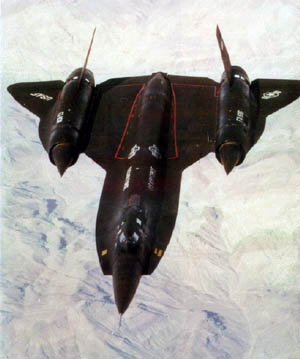Lockheed YF-12
|
|
| Lockheed YF-12A | ||
|---|---|---|

| ||
| Description | ||
| Role | Prototype interceptor | |
| Crew | two, pilot and WSO | |
| First Flight | August 7 1963 | |
| Manufacturer | Lockheed | |
| Dimensions | ||
| Length | 101 ft 7 in | 30.97 m |
| Wingspan | 55 ft 7 in | 16.95 m |
| Height | 18 ft 6 in | 5.64 m |
| Wing area | 1,795 ft² | 167 m² |
| Weights | ||
| Empty | 60,730 lb | 27,604 kg |
| Loaded | lb | kg |
| Maximum takeoff | 127,000 lb | 57,727 kg |
| Powerplant | ||
| Engines | 2x Pratt & Whitney J58 | |
| Thrust | 65,000 lbf | 290 kN |
| Performance | ||
| Maximum speed | 2,110 mph | 3,376 km/h |
| Mach 3.2 | ||
| Unrefuelled range | 2,500 miles | 4,000 km |
| Service ceiling | 85,000 ft | 25,914 m |
| Rate of climb | ft/min | m/min |
| Wing loading | lb/ft² | kg/m² |
| Thrust/weight | ||
| Avionics | ||
| Fire control radar | Hughes ASG-18 | |
| Armament | ||
| Missiles | 3x Hughes AIM-47B | |
The Lockheed YF-12 was a prototype interceptor aircraft that formed the basis for the SR-71 Blackbird.
The YF-12 program was a development of the A-12 Oxcart spy plane designed for the CIA. Lockheed was able to interest the Air Force in the project after it had been forced to cancel the XF-108 Rapier, a Mach 3 capable interceptor intended to replace the F-106 Delta Dart in service. It was pointed out that an aircraft based on the A-12 would provide a far cheaper alternative because much of the design and development work had already been done and paid for. In 1960, the USAF agreed to fund the conversion of three A-12s to YF-12A prototype interceptor configuration.
The main changes were modifying the aircraft's nose to accommodate the fire-control radar originally developed for the F-108, and the addition of a second cockpit for a crewmember to operate it. The nose modifications changed the aircraft's aerodynamics enough to require ventral fins to be mounted under the fuselage and engine nacelles to maintain stability. Finally, bays that had been used to house the A-12's reconnaissance equipment were converted to carry missiles.
Tests were extremely impressive, with the YF-12As setting a number of new speed and altitude records and demonstrating very promising results with their unique weapon system. In 1965, the Air Force placed an order for 93 F-12Bs, but this was cancelled due to budget cuts by Secretary of Defense Robert McNamara. The program was abandoned at that point, but the YF-12s continued flying for many years both with the Air Force and NASA as research aircraft.
Of the three YF-12s, one crashed during tests, one was cannibalised to provide parts for the SR-71C trainer, and the last is on display at the National Museum of the United States Air Force at Wright-Patterson Air Force Base near Dayton, Ohio.
A fourth aircraft, designated YF-12C, is believed to be an SR-71A converted for test purposes.
Image gallery
External link
- USAF Museum: YF-12 (http://www.wpafb.af.mil/museum/research/fighter/yf12.htm)
| Related content | |
|---|---|
| Related development | |
| Similar aircraft | |
| Designation series | |
| Related lists | List of military aircraft of the United States - List of fighter aircraft |
|
Lists of Aircraft | Aircraft manufacturers | Aircraft engines | Aircraft engine manufacturers Airports | Airlines | Air forces | Aircraft weapons | Missiles | Timeline of aviation |
